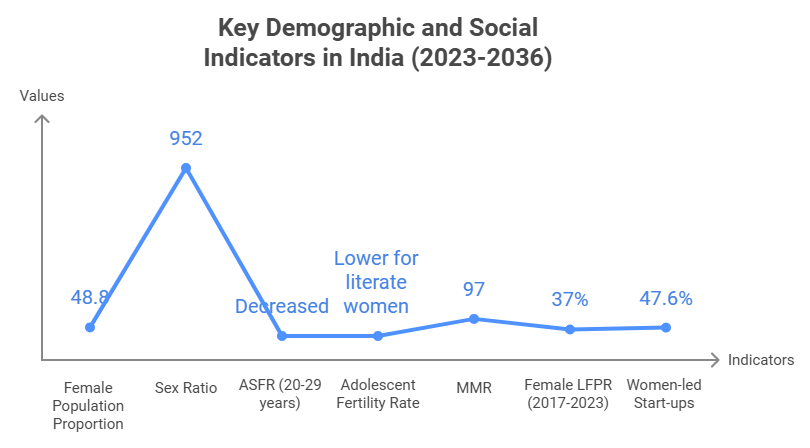Indian Economy
Rethinking New Population Strategy
- 23 Nov 2024
- 8 min read
For Prelims: Two-Child Policy, Local Body Elections, Aging Population, Fertility Rate, Total Fertility Rate (TFR), Replacement Level, Labor Shortages Skills Training, Job Creation, India Ageing Report 2023, India Employment Report 2024, Unplanned Urbanisation, Rights-Based Programs, Poverty Alleviation.
For Mains: Significance of Demographic Policies to Unleash Demographic Dividend for India.
Why in News?
Recently, Andhra Pradesh reversed its longstanding two-child policy, which had been in place for nearly three decades and prohibited individuals with more than two children from contesting local body elections to control population growth.
- The government argued that the state was facing the challenges of a rapidly aging population and a declining fertility rate, which could have serious long-term economic and social consequences.
What is the Need of the New Population Strategy in India?
- Declining Total Fertility Rate: India’s Total Fertility Rate (TFR) has seen a steady decline in recent decades. As per NFHS-5 (2019-21), India's TFR stands at 2.0 children per woman, which is below the replacement level of 2.1, below which the population begins to shrink in the long run.
- Some states like Andhra Pradesh (TFR of 1.5) are already well below this threshold, raising concerns about a shrinking workforce.
- This demographic shift could result in labor shortages and increased pressure on the working-age population, thereby reducing the potential for economic growth.
- Demographic Dividend for Economic Growth: With approximately 68% of the population in the working-age group (15-64 years) and 26% in the 10-24 age group, India is poised to become one of the youngest countries globally.
- A new population policy is crucial for harnessing this potential and addressing future challenges, along with an adequate investment in education, skills training, and job creation.
- Aging Population: As per the India Ageing Report 2023 of the United Nations Population Fund, over 20% of India’s population will be aged 60 or above.
- An ageing population in India poses challenges such as higher healthcare demand for chronic and geriatric care, necessitating family planning policies that address healthy ageing and elderly care.
- Resource Scarcity and Environmental Pressure: India's growing population strains natural resources, with cities like Delhi and Bangalore facing severe water stress, as per capita water availability drops.
- Furthermore, unplanned urbanization, driven by high population growth, leads to overburdened infrastructure, pollution, and slums, highlighting the need for a new population policy to avoid skewed development.
- Rising Inequality and Low Living Standards: Rapid population growth strains public resources, limiting access to healthcare, education, and social services.
- High fertility rates in impoverished areas exacerbate more comprehensive population policy for economic inequality.
India’s Population Policies
- Post-Independence Initiatives (1952): India pioneered global family planning programs, focusing on reducing birth rates through contraceptives and awareness campaigns.
- National Population Policy 1976: Recognising the link between population control and economic development, this policy emphasized measures such as incentivised sterilisation, increasing the legal marriage age (to 18 for girls and 21 for boys), and expanding access to education and healthcare.
- Emergency Period (1975–1977): This phase became infamous for forced sterilizations, eroding public trust in government-led population control measures.
- It highlighted the need for more inclusive and voluntary approaches.
- National Population Policy 2000: This policy set immediate goals to meet contraceptive needs and reduce maternal and infant mortality, a medium-term goal of achieving replacement-level fertility (TFR of 2.1), and a long-term objective of population stabilisation.
- Current Focus Areas: Modern strategies emphasise improving access to contraceptives, prioritising maternal and child health, and advocating for delayed marriage.
- Population stabilisation is now integrated with broader goals of economic growth and environmental sustainability.
- State-Level Policies: Some states like Uttar Pradesh and Assam have introduced policies promoting a two-child norm, linking it with incentives or restrictions in areas such as government jobs, welfare benefits, and electoral participation.
Way Forward
- Focus on Voluntary Family Planning: India must have rights-based family planning policies that empower individuals.
- Family planning strategies should empower women by enforcing laws against sex-selective abortion, promoting female literacy, and ensuring equal workforce opportunities, alongside education, economic independence, and social security.
- Emphasize a Region-Specific Approach: Given India’s demographic diversity, a region-specific approach is necessary.
- States with high fertility rates, such as Uttar Pradesh and Bihar, may need region-specific strategies, while states with low fertility rates, like Tamil Nadu and Andhra Pradesh, require policies tailored to their distinct needs.
- Family Planning as a Holistic Development Agenda: Family planning should be integrated into a broader socioeconomic development framework.
- Linking family planning with education, employment generation, and poverty alleviation will create a more sustainable development model that aligns with India's long-term growth and social justice goals.
- Strengthen Social and Healthcare Systems: India must invest in healthcare infrastructure and social security systems, especially to address the challenges posed by an ageing population.
- Expanding geriatric care facilities, promoting the silver economy, and offering flexible work arrangements for older workers can mitigate the pressures of a shrinking workforce.
|
Drishti Mains Question: What challenges does India face with its ageing population, and how can family planning policies address these issues? |
UPSC Civil Services Examination, Previous Year Question (PYQ)
Prelims:
Q. To obtain full benefits of demographic dividend, what should India do? (2013)
(a) Promoting skill development
(b) Introducing more social security schemes
(c) Reducing infant mortality rate
(d) Privatization of higher education
Ans: (a)
Mains:
Q. “Demographic Dividend in India will remain only theoretical unless our manpower becomes more educated, aware, skilled and creative.” What measures have been taken by the government to enhance the capacity of our population to be more productive and employable? (2016)
Q. “While we flaunt India’s demographic dividend, we ignore the dropping rates of employability.” What are we missing while doing so? Where will the jobs that India desperately needs come from? Explain. ? (2014)





